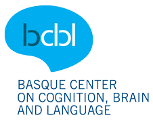Authors
Ileana Quiñones (a,b,c*†), Amaia Carrión-Castillo (a,c*†), Iñigo Diez (b†), Laura de Frutos-Sagastuy (a,d), Brendan Costello (a,c), David Carcedo (a), Lucía Manso-Ortega (a,d), Maksim Slivka (e), Abraham Sánchez (a,d), Anique Schüller (a,d), Pedro M. Paz Alonso (a,c), César Caballero-Gaudes (a,c), Manuel Carreiras (a,c,d)
Affiliations
a. Basque Center on Cognition, Brain, and Language (BCBL),20009 Donostia-San Sebastian, Spain
b. Biogipuzkoa Health Research Institute, 20014 Donostia-San Sebastian, Spain
c. IKERBASQUE. Basque Foundation for Science, 48009 Bilbao, Spain
d. University of the Basque Country, UPV/EHU, 48940 Bilbao, Spain
e. Center for Lifespan Changes in Brain and Cognition, Department of Psychology, University of Oslo, 0313 Oslo, Norway
† Equal contribution
* Correspondence: i.quinones@bcbl.eu, a.carrion@bcbl.eu
Abstract
The neural mechanisms underlying language processing involve a well-defined brain network, including mainly left perisylvian areas. Yet, the extent of individual variability remains largely unexplored, particularly in bilingual and multilingual contexts. Differences in linguistic profiles (e.g., age of acquisition, exposure, proficiency) provide an opportunity to assess how network topology is shaped by sociolinguistic factors. To address this, we developed NEUROLINGUA, a comprehensive database of functional and structural MRI data, enriched with sociodemographic, sociolinguistic, and behavioral information. It includes 725 healthy individuals aged 18-82 immersed in a Basque-Spanish multilingual environment, ranging from near-monolinguals to highly proficient multilinguals. Participants completed a functional MRI language localizer with both auditory and visual comprehension tasks, enabling cross-modal comparisons, as well as sentences involving arithmetic problem-solving. Exploratory analyses confirmed associations between structural MRI, sociodemographic, and cognitive measures. We demonstrate that NEUROLINGUA’s functional MRI data localize the language comprehension network and thus capture linguistic profile effects. This integrative dataset offers an unparalleled resource to investigate factors influencing language network adaptability and variability in diverse sociolinguistic contexts.
Usage Notes
The dataset featured in this preprint, complete with downloadable materials and codes accessible at NeuroLingua folder on the OpenNeuro platform (
OpenNeuro, Accession Number: ds006274), is freely available for use by academic researchers, institutions, and entities, on the condition that proper attribution is given to this work. The availability of this dataset is currently contingent on the publication of the article and the final management of the dataset following publication. Access will, in any case, be governed by the restrictions established by OpenNeuro for the openly shared dataset and by the BCBL for the use of T1-weighted images with defacing applied. The corresponding Data Use Agreement (DUA) will be made publicly available on the OpenNeuro platform once the dataset has been fully deposited. In the case of requests for T1 images for research purposes, the Data Use Agreement will be provided directly by the BCBL.
It is important to note that the authors disclaim any responsibility for the appropriate or inappropriate use in clinical or other contexts. Neither the name of the copyright holder nor the names of its contributors may be used to endorse or promote commercial products derived from this dataset without specific prior written permission.

